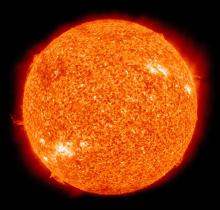Listen to today's episode of StarDate on the web the same day it airs in high-quality streaming audio without any extra ads or announcements. Choose a $8 one-month pass, or listen every day for a year for just $30.
You are here
The Dolphin
Many stars and constellations are named for people, but only a few of those people were real. One of them was an Italian astronomer who published a star catalog. And thanks to a practical joke, he has not one star named after him, but two.
Nicolo Cacciatore was assistant director of Palermo Observatory in Sicily. In the early 1800s, he began compiling a new edition of the Observatory’s star catalog.
When the catalog was released in 1814, it included two star names that no one had ever seen before: Sualocin and Rotanev. They were attached to the brightest stars of Delphinus, the dolphin. Before that, the stars had been known simply as Alpha and Beta Delphini. Other astronomers didn’t know what the names meant, and Cacciatore wasn’t telling.
Three decades later, though, a British astronomer solved the mystery of the names. The English version of Cacciatore’s name would be Nicholas Hunter. When that name is converted to Latin, it becomes Nicolaus Venator. Spell the two names backwards, and you get Sualocin and Rotanev — a bit of immortality for Nicolo Cacciatore.
Delphinus is a small constellation, and its stars are all faint. Even so, under a moderately dark sky it’s fairly easy to pick out. That’s because its outline really does look like a dolphin, swimming gracefully through summer skies. It’s about a third of the way up the eastern sky at nightfall, and soars high across the south later on.
We’ll have more about the dolphin tomorrow.
Script by Damond Benningfield





